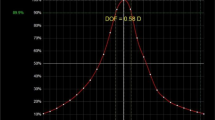Abstract
Purpose
To assess depth of field/depth of focus in pseudophakic eyes as function of visual acuity. Setting: Department of ophthalmology of National Medical Academy of Postgraduate Education.
Methods
Forty-three pseudophakic eyes of 43 patients after implantation in the capsular bag of monofocal posterior chamber IOLs were examined. All patients had visual acuities at least 20/20 for distance. Visual acuity was examined by charts consisting the Landolt’s rings under defined constant illumination within distance from 3 m to 20 cm from patients’ eyes at various distances with difference of 10 cm (29 measurements). Depth of field was calculated in diopters.
Results
The mean value of the depth of field in pseudophakic eyes with pupil diameter of 3 ± 0.3 mm was as follows: 1.12 D for visual acuity 20/20, 0.62 D for visual acuity 20/13, and 0.47 D for visual acuity 20/10.
Conclusions
Depth of focus correlates to normal levels of visual acuity. The higher the visual acuity, the lower the depth of focus. The ability of clear vision due to depth of focus-pseudoaccommodation is passive function. Separating the pseudoaccommodation from artificial accommodation in eyes with accommodative IOLs requires strict standardization of methodology especially regarding diameter of pupil, size of test objects, and level of illumination.




Similar content being viewed by others
References
Ciuffreda KJ (2007) Accommodation, the pupil, and presbyopia. In: Benjamin WJ (ed) Borish’s Clinical refraction. W.B. Saunders Company, pp 77–121
Oshima S (1958) Studies on the depth-of-focus of the eye. Jpn J Ophthalmol 2:63–72
von Bahr G (1952) Studies of the depth-of-focus of the eye. Acta Ophthalmol (Copenh) 30:39–44
Campbell FW (1957) The depth of field of the human eye. Opt Acta (Lond) 4:157–164
Charman WN, Whitefoot H (1977) Pupil diameter and the depth-of-field of the human eye as measured by laser speckle. Opt Acta (Lond) 24:1211–1216
Tucker J, Charman WN (1977) The depth-of-focus of the human eye for Snellen letters. Am J Optom Physiol Opt 53:3–21
Nio Y et al (2007) Effect of intraocular lens implantation on visual acuity, contrast sensitivity and depth of focus. J Cataract Refract Surg 29:2073–2081. doi:10.1016/j.jcrs.2003.07.007
Ogle KN, Schwartz JT (1959) Depth-of-focus of the human eye. Am J Optom Physiol Opt 49:273–280
Sergienko NM, Tutchenko NN (2007) Depth of focus: clinical manifestation. Eur J Ophthalmol 17:836–840
Bille JF, Buchler-Costa J, Muller F (2000) Optical quality of the human eye: the quest for perfect vision. In: Bille JF, Harner CFH, Loesel FH (eds) Aberration-free refractive surgery. Springer, Berlin Heidelberg New York, pp 61–82
Volz R, von Pape U (2000) Wavefront driven custom ablation: first clinical results. In: Bille JF, Harner CFH, Loesel FH (eds) Aberration-free refractive surgery. Springer, Berlin Heidelberg New York, pp 193–211
Findl O (2003) Intraocular lens movement caused by ciliary muscle contraction. J Cataract Refract Surg 29:667–676
Thornton SP (2005) Restoring accommodation: what is real and what is pseudo? J Cataract Refract Surg 31:1851–1852
Dogru M et al (2005) Early visual results with the 1 CU accommodating intraocular lens. J Cataract Refract Surg 31:895–902
Mastropasqua L et al (2003) Clinical study of the 1CU accommodating intraocular lens. J Cataract Refract Surg 29:1307–1312
Doane JF, Morris S, Borer AD, EuDaly LS, Denning JA (2000) Wavefront analysis: clinical primer. In: Bille JF, Harner CFH, Loesel FH (eds) Aberration-free refractive surgery. Springer, Berlin Heidelberg, New York, pp 93–123
Langenbucher A et al (2002) Measurement of accommodation after implantation of an accommodating posterior chamber intraocular lens. J Cataract Refract Surg 29:677–685
Atchison DA (2005) Pseudoaccommodation with forward movement of IOLs. J Cataract Refract Surg 31(1):11
Koeppl C et al (2005) Pilocarpine induced shift of an accommodating intraocular lens: AT-45 Crystalline. J Cataract Refract Surg 31:1290–1297
Dell SJ (2005) Pilocarpine-induced shift of an accommodating IOL. J Cataract Refract Surg 31:1469–1477
Author information
Authors and Affiliations
Corresponding author
Additional information
Authors have no financial interest in any material or method mentioned.
Rights and permissions
About this article
Cite this article
Sergienko, N.M., Kondratenko, Y.N. & Tutchenko, N.N. Depth of focus in pseudophakic eyes. Graefes Arch Clin Exp Ophthalmol 246, 1623–1627 (2008). https://doi.org/10.1007/s00417-008-0923-3
Received:
Revised:
Accepted:
Published:
Issue Date:
DOI: https://doi.org/10.1007/s00417-008-0923-3




